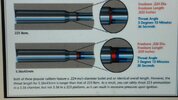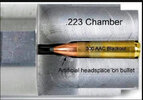TLDR: A buddy of mine made some remarks a few days ago that have me questioning the conventional wisdom on .223 and 5.56.
Ok, so here's the TL part: For decades, I've heard the conventional wisdom that "you can shoot .223 in a 5.56 rifle, but not the other way around, because of pressure issues." When it comes to guns, I generally follow conventional wisdom unless and until I can do sufficient research to determine for myself that it's wrong. Given that I'm a lawyer and not an engineer, that doesn't happen often. So I recently bought a Howa Mini in .223. It's a nice rifle, but historically, I've never really kept .223 on hand. I've had a couple of 5.56 rifles over the years, and generally bought 5.56 ammo for them. I do have some loose .223/5.56, and there's likely some of each mixed in those batches together. The odds of me successfully sorting out the .223 from the 5.56 rapidly approaches zero. So ..... I was left with a dilemma: (a) buy .223 specifically for the Howa; (b) sell the Howa and buy something in 5.56; or (c) risk shooting 5.56 ammo out of a perfectly good .223.
So I mentioned this to my buddy. He tells me not to worry about it, nothing bad will happen. Now, had this been some Nine-Fingered Ned with a history of accidentally blowing stuff up, I'd have smiled, nodded, and ignored him. But he's a very good gunsmith, and knows far more about firearms than I do. And then he said that gun companies won't build a .223 that is so ammo sensitive as to be dangerous if you're shooting 5.56, or damaged by it. He says that the liability of building a rifle that will chamber two different rounds, only one of which is safe to shoot, is a lawsuit waiting to happen. Now he's talking my language. We all know I'm no engineer, but I do have a basic understanding about how litigation costs can drive product design... And if I worked at a gun company, there's no way I would approve such a thing.
So I guess my question is this: Have y'all ever seen a .223 rifle that was actually damaged by shooting 5.56? And I mean without other complications, like a double-charge of powder, a squib or a manufacturing defect. Damage or danger directly traceable to ammo selection.
Ok, so here's the TL part: For decades, I've heard the conventional wisdom that "you can shoot .223 in a 5.56 rifle, but not the other way around, because of pressure issues." When it comes to guns, I generally follow conventional wisdom unless and until I can do sufficient research to determine for myself that it's wrong. Given that I'm a lawyer and not an engineer, that doesn't happen often. So I recently bought a Howa Mini in .223. It's a nice rifle, but historically, I've never really kept .223 on hand. I've had a couple of 5.56 rifles over the years, and generally bought 5.56 ammo for them. I do have some loose .223/5.56, and there's likely some of each mixed in those batches together. The odds of me successfully sorting out the .223 from the 5.56 rapidly approaches zero. So ..... I was left with a dilemma: (a) buy .223 specifically for the Howa; (b) sell the Howa and buy something in 5.56; or (c) risk shooting 5.56 ammo out of a perfectly good .223.
So I mentioned this to my buddy. He tells me not to worry about it, nothing bad will happen. Now, had this been some Nine-Fingered Ned with a history of accidentally blowing stuff up, I'd have smiled, nodded, and ignored him. But he's a very good gunsmith, and knows far more about firearms than I do. And then he said that gun companies won't build a .223 that is so ammo sensitive as to be dangerous if you're shooting 5.56, or damaged by it. He says that the liability of building a rifle that will chamber two different rounds, only one of which is safe to shoot, is a lawsuit waiting to happen. Now he's talking my language. We all know I'm no engineer, but I do have a basic understanding about how litigation costs can drive product design... And if I worked at a gun company, there's no way I would approve such a thing.
So I guess my question is this: Have y'all ever seen a .223 rifle that was actually damaged by shooting 5.56? And I mean without other complications, like a double-charge of powder, a squib or a manufacturing defect. Damage or danger directly traceable to ammo selection.



